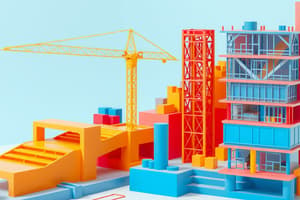Podcast
Questions and Answers
What is the significance of the 3D printed house in Beckum, Germany?
What is the significance of the 3D printed house in Beckum, Germany?
What is the printing speed of the Cobod's modular Bod2 printing system?
What is the printing speed of the Cobod's modular Bod2 printing system?
How many operators are required to set up the Cobod's modular Bod2 printing system on site?
How many operators are required to set up the Cobod's modular Bod2 printing system on site?
What is the goal of Peri's 'disruptive products and technologies' department?
What is the goal of Peri's 'disruptive products and technologies' department?
What is one of the implications of integrating 3D printing into the construction process?
What is one of the implications of integrating 3D printing into the construction process?
What makes Peri's project in Germany distinct from previous 3D printed building projects?
What makes Peri's project in Germany distinct from previous 3D printed building projects?
What benefit has the integration of 3D printing had on labor costs?
What benefit has the integration of 3D printing had on labor costs?
What is one of the challenges that needs to be overcome before 3D printing becomes a widespread building technique?
What is one of the challenges that needs to be overcome before 3D printing becomes a widespread building technique?
What is the team's plan for the future of 3D printing in construction?
What is the team's plan for the future of 3D printing in construction?
What has been the result of engaging core trades on the project?
What has been the result of engaging core trades on the project?
Flashcards are hidden until you start studying
Study Notes
• The first 3D printed house to be fully certified under a national government's building regulations has been completed in Germany, marking a significant milestone in the development of 3D printing technology for construction.
• The 3D printed house, located in Beckum, Germany, offers 160 square meters of living space across its two stories and is the first certified 3D printed building in Germany.
• The structure was developed by leading formwork and scaffolding firm Peri, in collaboration with its project partners, using Cobod's modular Bod2 printing system.
• The printer requires only two operators and takes less than 48 hours to set up on site, and can print as fast as one meter per second using data from integrated design models.
• Peri's team is now working on the largest 3D printed multi-family house in Europe, with 380 square meters of living space divided into five apartments across three levels.
• The company's "disruptive products and technologies" department has been actively pursuing 3D construction printing for years, with the goal of developing projects that might substitute their current core products.
• The 3D printed house has been certified with a national building accreditation, paving the way for larger and more complex projects.
• The integration of 3D printing into the construction process has significant implications for reducing waste, labor shortages, and construction time.
• Peri's project in Germany is distinct from previous 3D printed building projects in Dubai and the Netherlands, as it focuses on real-world architectural scale permitted residential buildings that meet strict German building codes.
• The project has included project partners from the start, working directly with construction companies and architects to ensure that the buildings are fully integrated into the construction process.
• The team has also engaged core trades on the project, such as electricians, to coordinate services and structural design, resulting in significant savings of time, money, and waste material.
• The integration of 3D printing has reduced labor costs, with electricians reporting savings of up to 12 days in certain projects.
• The team plans to use the lessons learned from this project to construct larger structures in a variety of forms, using different materials and focusing on further reducing waste.
• Despite the progress made, there are still challenges to overcome before 3D printing becomes a widespread building technique, including educating people about the technology and its potential benefits.
Studying That Suits You
Use AI to generate personalized quizzes and flashcards to suit your learning preferences.




